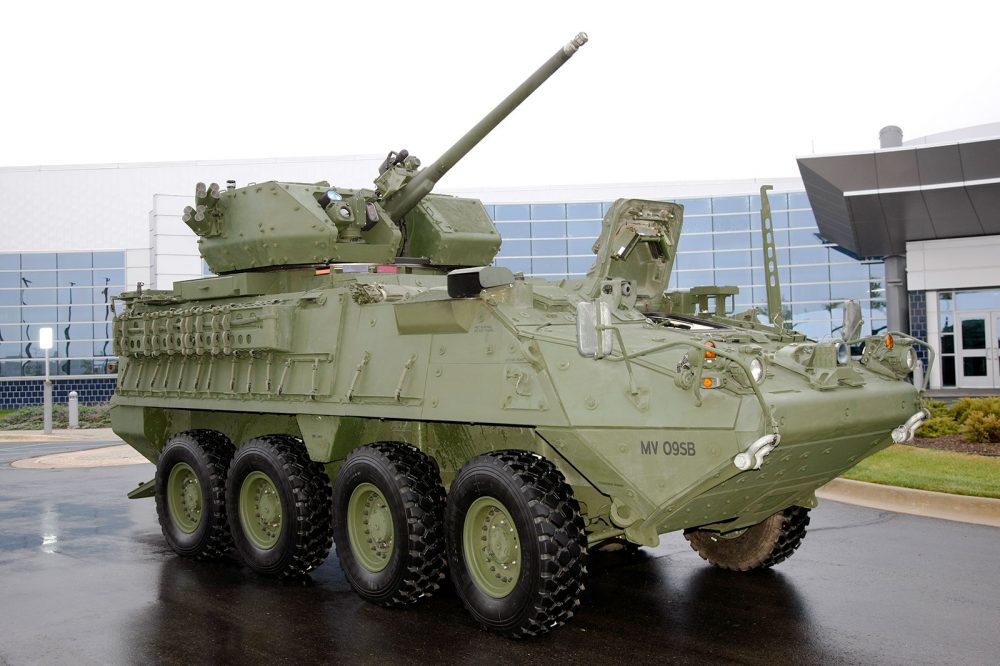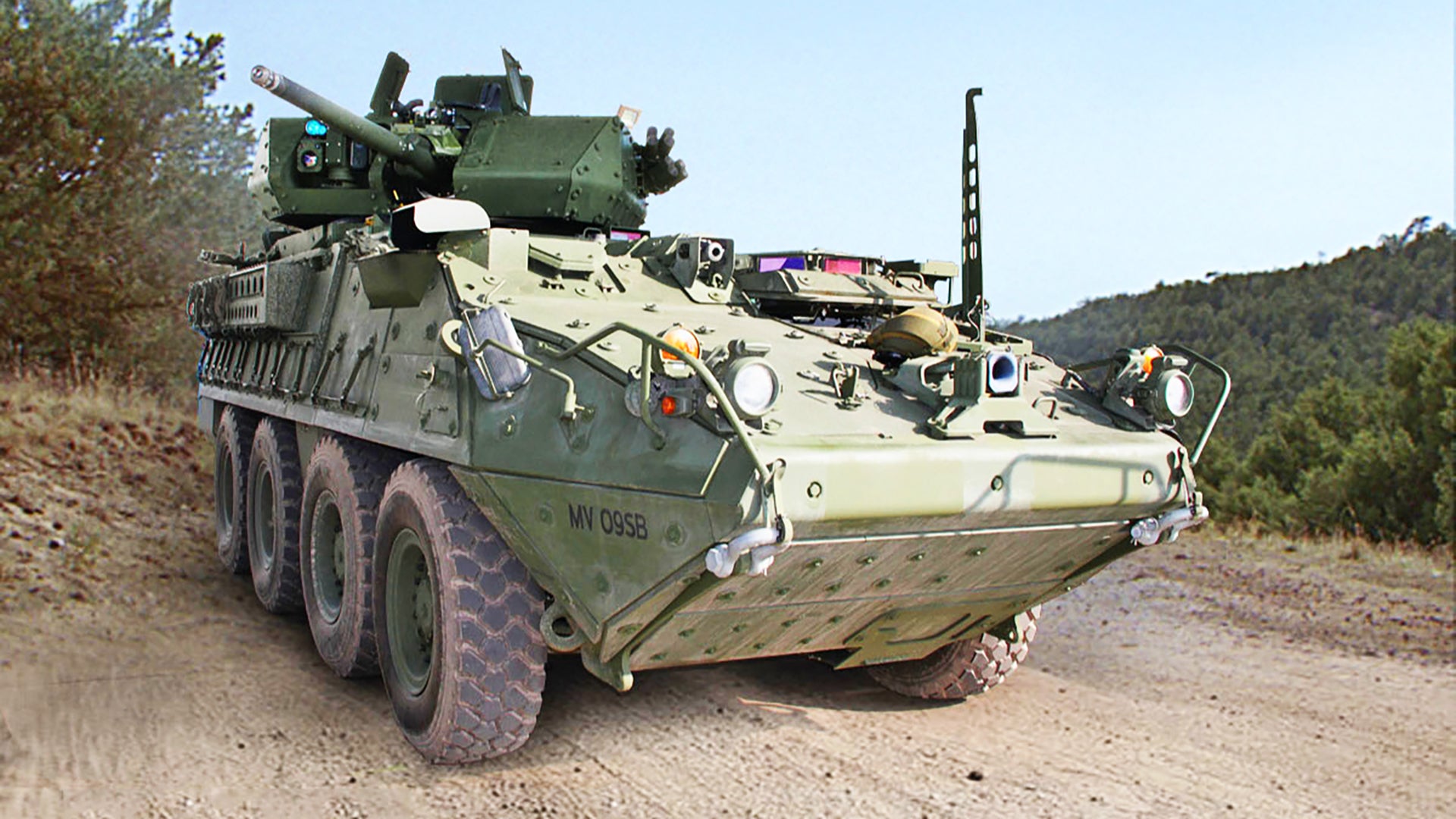Two new Stryker armored combat vehicle configurations are being fielded to the U.S. Army and are currently undergoing drills at Aberdeen Proving Grounds in Maryland. The vehicles are the result of a two year initiative that aims to give the Stryker far more firepower and engagement range.
These requirements are primarily based around the Germany-based 2nd Cavalry Regiment’s need to better deter Russia in eastern Europe, and if need be, confront Russian armored fighting vehicles that are equipped with heavier weapons that the .50 caliber machine guns found on most Strykers. It is also in response to the proliferation of crudely modified civilian trucks that are made to carry powerful weapons such as anti-aircraft guns. Commonly known as “technicals,” these improvised combat vehicles are all too common on the battlefields of Northern Africa and the Middle East.

One of the new Stryker configurations, dubbed the “Dragoon” like its 2nd Cavalry Regiment owners, or more formally the Stryker Carrier Vehicle Dragoon, features a 30mm Bushmaster cannon. The design also uses the latest tech from other Stryker models, including the suspension from the “double v” ambush and mine-resistant Stryker’s hull and mature combat system components.
It only took 18 months for the program to go from a Powerpoint presentation to where it is today—lightning speed in terms of defense acquisition. $300 million in emergency funding was allocated for the project by Congress in 2015, when Russia’s far more aggressive international posture was still quite new.
The Orbital ATK XM813 30X173mm cannon used on the Dragoon is a derivative of the Mk44 Bushmaster II cannon—a highly capable, reliable and versatile weapon. Derivatives of the Mk44 fly on AC-130J gunships and are installed on Littoral Combat Ships and San Antonio class amphibious assault ships, not to mention many other weapon systems applications around the globe.
The XM813 can engage targets out to over 9,000 feet, way farther than the Stryker’s standard .50 caliber machine guns, and with much greater impact and lethality. It fires the same ammunition as the A-10 Warthog’s GAU-8 Avenger cannon, but it can also fire programmable air burst rounds, giving it the ability to take out human targets hiding behind barriers and inside window and doorways. It can also use this ammunition to work as a short-range air defense battery against low-flying drones and helicopters.
Here is a similar setup in action that is offered for the Bradley Fighting Vehicle:

The gun has a variable rate of fire of 100 or 200 rounds per minute and has two magazines with 78 rounds each as well as another 264 rounds stored in the Stryker’s hull. The gun’s unmanned turret is a Kongsberg Protech Systems Medium Caliber Remote Weapons Station. In all the installation adds two tons to the Stryker’s mass but it doesn’t impede the vehicles basic duty—transporting around a nine man squad plus a driver and a gunner.
The 30mm cannon is not meant to give the Stryker the ability to take on columns of enemy advanced heavy armor offensively, but it does give Stryker units a far more robust defensive capability against those types of threats.
One of the drawbacks of this configuration is reduced visibility because crews can’t simply pop their head out a hatch to see what’s around them as the turret is remotely operated. General Dynamics has tried to mitigate this with a modified view port layout, but commanders already doubt if Dragoon Strykers can lead a formation due to this issue. If anything else, it sounds like the Dragoon is a ripe candidate for a virtual viewing/augmented reality setup to enhance crew situational awareness. But before that’s a possibility, the 2nd Cavalry Regiment will learn how to better fight with remote weapons turrets in a “buttoned up” fashion, and what tactics can be put to use to minimize this disadvantage.
The second new Stryker configuration intended for the 2nd Cavalry Regiment as well as all other Stryker units features the CROWS-J remote weapons turret. The Common Remotely Operated Weapon System (CROWS) is already found on many US military fighting vehicles, but this new version features FGM-148 Javelin anti-tank missiles in addition to its machine gun. This gives Stryker crews the ability to employ highly precise and deadly standoff weaponry against everything from troop formations, to helicopters, to heavily armored targets from the safety of their vehicles.


Javelins are commonplace in US Army units, including the 2nd Cavalry Regiment, but they are fired from the shoulder using a cumbersome thermal targeting device. CROWS-J allows for that functionality to be integrated into the Stryker itself and at its crew’s fingertips using CROWS advanced optical targeting and surveillance suite. The Stryker mounted Javelins have a range of two miles and can execute indirect “overhead” attacks as well as direct attacks. Many Strykers already have a CROWS installation, so this will be an upgrade to those systems.
Currently the Army has budgeted for 83 “Dragoon” 30mm cannon equipped Strykers, all of which are allocated to the 2nd Cavalry Regiment and will begin showing up in Germany in January 2018 if everything goes as planned. They will likely find themselves in Eastern Europe soon after their arrival on the continent. If the project turns out to be highly successful, other Stryker units could begin receiving similar modifications, but presently there are no funds set aside to realize such a plan.
Contact the author: Tyler@thedrive.com
